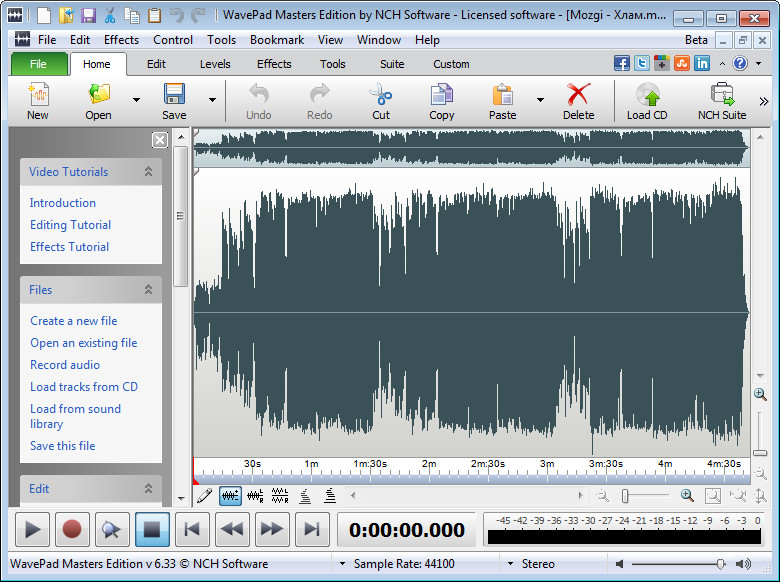Install NCH WavePad 11.44, Don’t click Launch, close the program (End Task from task manager). Open the enCrack folder, then copy and paste the files in it into the installation folder on your PC or laptop, and run it. Select the target product. Some products will require extra information. This audio editing software is a full-featured professional audio and music editor for Windows and Mac. Record and edit music, voice and other audio recordings. When editing audio files, you can cut, copy and paste parts of recordings, and then add effects like echo, amplification and noise reduction.
WavePad is a sound editor program for Windows. WavePad lets you make and edit voice and other audio recordings. You can cut, copy and paste parts of recording and, if required, add effects like echo, amplification and noise reduction.
WavePad Masters Edition Features:
* Sound editing functions include cut, copy, paste, delete, insert, silence, autotrim and more
* Audio effects include, amplify, normalize, equaliser, envelope, reverb, echo, reverse, sample rate conversion and more
* Special effects include reduce vocals, distortion, chorus and more
* Batch processing allows you to apply effects and/or convert your files as a single function
* Audio restoration features including noise reduction and click pop removal
* Recorder supports autotrim and voice activated recording
* Create and work on multiple audio files at one time and save them as one project
* Supports sample rates from 6000 to 96000Hz, stereo or mono, 8, 16, 24 or 32 bits
* Tools include spectral analysis (FFT) and speech synthesis (text to speech)
* Ability to work with multiple files at the same time in seperate screens
WavePad Masters Edition Features:
* Sound editing functions include cut, copy, paste, delete, insert, silence, autotrim and more
* Audio effects include, amplify, normalize, equaliser, envelope, reverb, echo, reverse, sample rate conversion and more
* Special effects include reduce vocals, distortion, chorus and more
* Batch processing allows you to apply effects and/or convert your files as a single function
* Audio restoration features including noise reduction and click pop removal
* Recorder supports autotrim and voice activated recording
* Create and work on multiple audio files at one time and save them as one project
* Supports sample rates from 6000 to 96000Hz, stereo or mono, 8, 16, 24 or 32 bits
* Tools include spectral analysis (FFT) and speech synthesis (text to speech)
* Ability to work with multiple files at the same time in seperate screens
 I have noticed a lot of questions on our YouTube channel about enhancing the bass in a song using WavePad audio editor. How is it done? Since the graphical interface of WavePad's equalizer was recently updated, now is the perfect time to review how to use it.
I have noticed a lot of questions on our YouTube channel about enhancing the bass in a song using WavePad audio editor. How is it done? Since the graphical interface of WavePad's equalizer was recently updated, now is the perfect time to review how to use it.
The first thing you want to do is load your music into WavePad. Do this by clicking the
Next, click the Effects menu and select Equalizer.
 This will open the Equalizer dialog, which might not be what you expect if you were looking for knobs and dials. This equalizer still weakens and strengthens frequencies like knobs on a mixing board, but represents the frequencies in graph form. The graph works logically enough; the low frequencies are represented on the left of the graph, the high frequencies on the right. If there is a point on the graph line that is higher, that frequency will be stronger. If the graph point is lower, the frequency will be weaker.
This will open the Equalizer dialog, which might not be what you expect if you were looking for knobs and dials. This equalizer still weakens and strengthens frequencies like knobs on a mixing board, but represents the frequencies in graph form. The graph works logically enough; the low frequencies are represented on the left of the graph, the high frequencies on the right. If there is a point on the graph line that is higher, that frequency will be stronger. If the graph point is lower, the frequency will be weaker.The easiest way familiarize yourself with this equalizer is to make use of the presets. Don't be afraid to play around with them and to adjust their settings to see how they affect your music--you don't have to commit to any changes until you click Apply.
Let's boost the bass as an example. Click the Play button and then select the Low Pass filter from the list of presets. You'll hear the higher frequencies drop down, giving a boosted effect to the bass. The result probably isn't exactly the sound you imagined, so you can make adjustments based on this starting place to even out the sound how you want. You can do this using the Low Pass Options dialog that opened when you selected this preset, but you'll have more control if you close the dialog and move around the graph points yourself. You can also add graph points by clicking on the graph's line.
For more information about how to use the different equalizer presets, view the Effects topic in the help manual. For more information about frequencies, view the General Audio Concepts
Wavepad 2019
topic, also in the help manual. The help manual is accessed by pressing F1 from the program.Wavepad Crack 2019
Wavepad Registration Code 2019 Free
To try WavePad and boost your bass, download the program from our website. You'll also want to see the other audio software we have for maximizing your audio production.